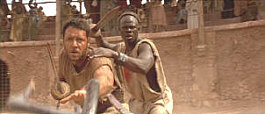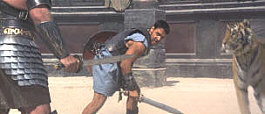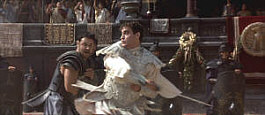Gladiator appears in an aspect ratio of approximately 2.35:1 on this single-sided, double-layered DVD; the image has been enhanced for 16X9 televisions. While the picture didn’t appear flawless, it nonetheless seemed quite good throughout the film.
Sharpness looked crisp and detailed at all times. I saw no discernible instances of softness or fuzziness, and the picture maintained solid and accurate focus. Moiré effects and jagged edges presented no concerns, and I witnessed no signs of edge enhancement. Print flaws seemed largely absent. I detected a little grit and a few speckles, but these were minor defects in an otherwise clean and clear image,.
Colors appeared nicely accurate within the stylistic dimensions of the flick. The film went for a quiet palette and the DVD replicated it neatly, with hues that looked solidly-saturated and rich. Black levels were properly deep and dark, while shadow detail seemed appropriately heavy but not excessively thick. Overall, Gladiator presented a picture that generally lived up to my expectations.
 Also very good were the film’s soundtracks. Gladiator provides both Dolby Digital EX 5.1 and DTS ES 6.1 mixes. I preferred the DTS edition by a small margin, though both tracks worked well. My comments will initially address the DTS mix and I’ll discuss the differences I heard in the DD track during a separate paragraph.
Also very good were the film’s soundtracks. Gladiator provides both Dolby Digital EX 5.1 and DTS ES 6.1 mixes. I preferred the DTS edition by a small margin, though both tracks worked well. My comments will initially address the DTS mix and I’ll discuss the differences I heard in the DD track during a separate paragraph.
For most of Gladiator, the soundfield seemed very involving and active. All five channels received a good workout as they displayed a great deal of discrete sound throughout the film. While the action scenes offered the showiest moments, I generally preferred some of the quieter scenes; Gladiator did a very nice job with segments that featured gentle ambiance as these bits came across in a natural and convincing manner. In general, the atmosphere found during the movie seemed excellent.
As a whole, the audio quality was good but slightly erratic. Dialogue usually appeared distinct and natural, but some lines seemed somewhat muddled and flat; a surprising amount of speech was stiff and dull, though intelligibility was never an issue. Music sounded clear and bright and displayed adequate range. Effects were generally clean and accurate, and they presented good punch. Low-end varied worked well and added a lot of power to the mix. Overall, the DTS audio was very satisfying.
How did the DTS and Dolby Digital mixes differ? As is often the case, I thought the DD track appeared slightly more thin and drab. The soundfields appeared similarly engaging and involving, but the Dolby audio displayed weaker dynamics and less bass. I also found the speech a little more brittle and thin. One note: the DTS track was mastered at a considerably higher level - it’s much louder than the DD mix. But even with compensation made for the volume levels, the DTS audio seemed somewhat more rich and full.
 Gladiator marks DreamWorks’ first two-DVD effort, and its complement of supplements doesn’t disappoint. The first disc is devoted completely to the film itself with only one extra to be found: a running audio commentary from director Ridley Scott, director of photographer John Mathieson, and editor Pietro Scalia. Not surprisingly, Scott dominates the track; the other two chime in their remarks and impressions from time to time, but the director presents the majority of the information.
Gladiator marks DreamWorks’ first two-DVD effort, and its complement of supplements doesn’t disappoint. The first disc is devoted completely to the film itself with only one extra to be found: a running audio commentary from director Ridley Scott, director of photographer John Mathieson, and editor Pietro Scalia. Not surprisingly, Scott dominates the track; the other two chime in their remarks and impressions from time to time, but the director presents the majority of the information.
All in all, the commentary offers a nicely broad and engaging discussion of the film. A wide variety of topics receive mention, from casting issues to sets and locations to story and themes to the use of special effects to historical accuracy. Scott seems frank with his opinions and distributes them freely. At times he gets bogged down in too much information about which scenes feature what kinds of effects, but most of the time the commentary nicely complemented the movie.
As I alluded, the bulk of this set’s supplements appear on the second DVD. Here we find a nice mix of different extras. First we get From the Cutting Room Floor, a package of 11 different deleted scenes. These range in length from 29 seconds to three minutes, 54 seconds for a total of about 16 and a half minutes of footage. For the most part, these are some interesting clips. Most of them show new aspects of the characters and situations and are consistently higher quality than most deleted shots.
In addition to these 11 scenes, we get a seven minute and 10 second montage of cut snippets. Called “The Treasure Chest”, it consists of tidbits that are very brief and wouldn’t make much sense shown on their own; examples include shots of close-up violence during gladiator competitions. The sequence is accompanied by pieces of the score and forms a funky kind of music video.
 The scenes can be viewed either with their original audio or with commentary from Scott. He continues to offer insightful remarks for these shots and nicely answers the most pertinent and persistent question: why were the segments dropped? Anything beyond that is gravy in my book, and I enjoyed Scott’s comments. Note that “The Treasure Chest” includes no commentary.
The scenes can be viewed either with their original audio or with commentary from Scott. He continues to offer insightful remarks for these shots and nicely answers the most pertinent and persistent question: why were the segments dropped? Anything beyond that is gravy in my book, and I enjoyed Scott’s comments. Note that “The Treasure Chest” includes no commentary.
Nice touch: each of the deleted scenes offers a text synopsis on the menu screen so you can know what they’re about before you view them. Annoying touches: we aren’t given the option to view all the segments straight through, and it requires too many button pushes to access a scene. You need to select the title in the menu, press “enter”, then wait for the synopsis to come up before you move the cursor to the right to highlight the selection and then press “enter” again. Yeah, it doesn’t sound like any big deal, but multiply this by 12 and it gets a little old.
Next up is the first of three video documentary features. “The Making of Gladiator” provides a general look at the creation of the film. This 25-minute program seems largely promotional in nature - it’s the kind of thing you’d see on cable between movies - but it includes more depth and detail than usual. It mixes film clips, shots from the set, and interview snippets with Scott, Crowe, Phoenix, Richard Harris plus other actors and crew. The “behind the scenes” material is informative - especially through the active way in which it depicts the use of special effects - and the interviews are fun; for example, Harris amusingly discusses his perpetual threats to retire. Overall, it’s a nice little program.
Even better is the next show. Called “Gladiator Games: Roman Blood Sport”, I expected this 50-minute program to give us another semi-promotional look at the movie, but I received a surprise. Instead, it mainly focuses on the historical facts behind the story. We find a mix of interviews with historians and images that re-enact the events to a mild degree; mostly the latter provide a general sense of the era and not of the specific violent acts. A little of the piece discusses Gladiator itself, but not much; only about six minutes of it are devoted to this subject. It’s a good view of the facts behind the movie.
 The final video program focuses on the film’s music. “Hans Zimmer: Composing Gladiator” takes 20 minutes and 40 seconds to concentrate on Zimmer’s work for the movie. Happily, this show sticks with lots of content and little fluff; most of it features interviews of Zimmer as he discusses his music and relates the specific concepts he attempted to communicate in the movie. It’s a solid little show that nicely illuminated Zimmer’s work.
The final video program focuses on the film’s music. “Hans Zimmer: Composing Gladiator” takes 20 minutes and 40 seconds to concentrate on Zimmer’s work for the movie. Happily, this show sticks with lots of content and little fluff; most of it features interviews of Zimmer as he discusses his music and relates the specific concepts he attempted to communicate in the movie. It’s a solid little show that nicely illuminated Zimmer’s work.
Another piece of “inside” information comes from My Gladiator Journal, a text written by child actor Spencer Treat Clark, who played young Lucius in the film. It’s a surprisingly long segment that relates Clark’s experiences on the movie in a fairly detailed manner. Of course, a lot of it consists of “this is soooo cool!” talk, but it’s still a fun little addition to the disc.
Trailers and TV Spots includes a few different promotional pieces. We get the teaser and theatrical trailers for Gladiator plus four different TV ads.
Production Notes features more text. We find 13 screens worth of information about the movie. Some of the details were redundant after the other extras, but I thought the notes were surprisingly complete and compelling.
DreamWorks offer more Cast and Crew biographies than any other DVD studio, and Gladiator is no exception. Here we discover nine listings for actors and 12 entries for crew members. Each of these are reasonably detailed though not especially fascinating. Still, it’s a nice combination of quantity and quality.
Two other sections provide a wealth of stillframe materials. In the Still Gallery, we see 187 photographs. These include publicity shots, scenes from the film, and many candid snaps from the set. The photos are divided into six different topics, and they can be accessed either through these subsections or viewed as a whole.
 The Storyboards area covers a whopping 355 screens. Each of these provides at least two boards, with some screens featuring three or more images. I thought these were unusually well-executed; the boards came together to resemble a comic book. All in all, 12 scenes are documented here; four of those were deleted segments, which were the most interesting of the bunch. Each of the 12 segments can be seen individually or you can watch all 355 boards in succession.
The Storyboards area covers a whopping 355 screens. Each of these provides at least two boards, with some screens featuring three or more images. I thought these were unusually well-executed; the boards came together to resemble a comic book. All in all, 12 scenes are documented here; four of those were deleted segments, which were the most interesting of the bunch. Each of the 12 segments can be seen individually or you can watch all 355 boards in succession.
As far as DVD-ROM materials go, Gladiator only includes a link to the film’s website. It appeared decent as far as such sites go but wasn’t anything special.
The same statement applies to my feelings about Gladiator as a movie. Ultimately I thought it was mildly interesting as a whole, and the terrific battle scenes kept me going, but far too much of the film plodded along and provided little of interest. The framework would support a strong story but this one’s characters and non-action situations lacked much life. The DVD presented a very good picture and sound plus some excellent extras. Despite my reservations, Gladiator deserves a rental since it includes enough exciting material to make the less-stimulating sequences palatable.

